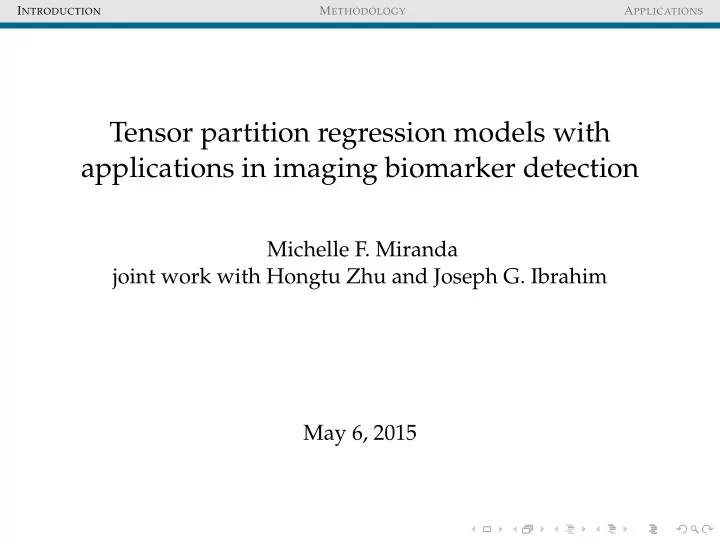

I NTRODUCTION M ETHODOLOGY A PPLICATIONS Tensor partition regression models with applications in imaging biomarker detection Michelle F. Miranda joint work with Hongtu Zhu and Joseph G. Ibrahim May 6, 2015
I NTRODUCTION M ETHODOLOGY A PPLICATIONS G ENERAL GOAL The development of new statistical tools that allow us to look at the whole brain and to establish associations between what do we see inside and the external world.
I NTRODUCTION M ETHODOLOGY A PPLICATIONS S PECIFIC GOAL Identify imaging biomarkers that are relevant to predict disease status.
I NTRODUCTION M ETHODOLOGY A PPLICATIONS W HAT ARE THE CHALLENGES ? ◮ Typical image size 256 × 256 × 256 ≈ 17 million voxels ◮ After downsizing + cropping 96 × 96 × 96 ≈ 885 . 000 voxels
I NTRODUCTION M ETHODOLOGY A PPLICATIONS U NDERSTANDING THE T ENSOR D ECOMPOSITION ◮ Tensor=multidimensional array ◮ Order= dimension of the tensor ◮ Rank one tensors
I NTRODUCTION M ETHODOLOGY A PPLICATIONS W HAT DO WE PROPOSE ? Strategy adopted: partitions!! We increase the chances that small regions are captured!!
I NTRODUCTION M ETHODOLOGY A PPLICATIONS A RE THE PARTITIONS NECESSARY ? ◮ T1-weighted 64 × 108 × 99 ◮ Top: no-partition ◮ Bottom: 24 partitions of size 32 × 27 × 33
S OLUTION - H IERARCHICAL MODEL 3 Factor Model 1 Partition the images 4 GLM on extracted features with 2 Tensor decomposition sparse priors
I NTRODUCTION M ETHODOLOGY A PPLICATIONS D OES IT IMPROVE PREDICTIONS ?
I NTRODUCTION M ETHODOLOGY A PPLICATIONS R EAL DATA ANALYSIS - ADNI Data: 402 MRI scans from ADNI1, 181 of them were diagnosed with AD, and 221 healthy controls.
I NTRODUCTION M ETHODOLOGY A PPLICATIONS R ESULTS ◮ Based on a 95 % credible interval 36 basis are important to predict AD outcome ◮ Posterior mean of the projection P = � Λ; A ( 1 ) , A ( 2 ) , A ( 3 ) , ˜ P � ◮ 95 % credible interval for P reveals the regions of the biomarkers selected to predict the AD outcome
I NTRODUCTION M ETHODOLOGY A PPLICATIONS B IOMARKERS ◮ White matter: cingulum, fascicle, fornix ◮ Temporal lobe: hippocampus ◮ Parietal lobe: superior parietal lobe ◮ Frontal lobe: premotor cortex, primary motor cortex Vemuri and Jack Jr. Role of structural MRI in Alzheimers disease. Alzheimers Research Therapy 2010, 2:23
I NTRODUCTION M ETHODOLOGY A PPLICATIONS W HY THE FACTOR MODEL IS NECESSARY ? ◮ To reduce features ◮ To account for multicolinearity
I NTRODUCTION M ETHODOLOGY A PPLICATIONS P ARTITION S ELECTION Partition size 24 × 24 × 24 12 × 12 × 12 6 × 6 × 6 R = 5 — — 0.7813 R = 10 0.6714 0.7311 0.7613 R = 20 0.6937 0.7587 0.7588 R = 30 0.5770 0.6544 — No partition 1 × 1 × 1 R = 100 0.7498 — — Table: Mean prediction accuracy for a 10-fold cross-validation procedure. There is a smaller error measurement with an increase of the rank R .
Recommend
More recommend